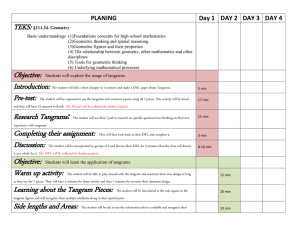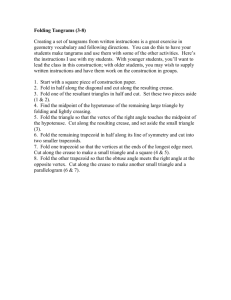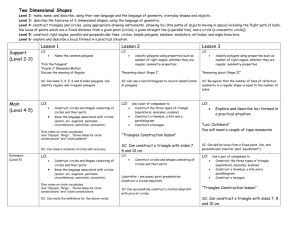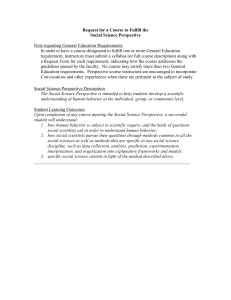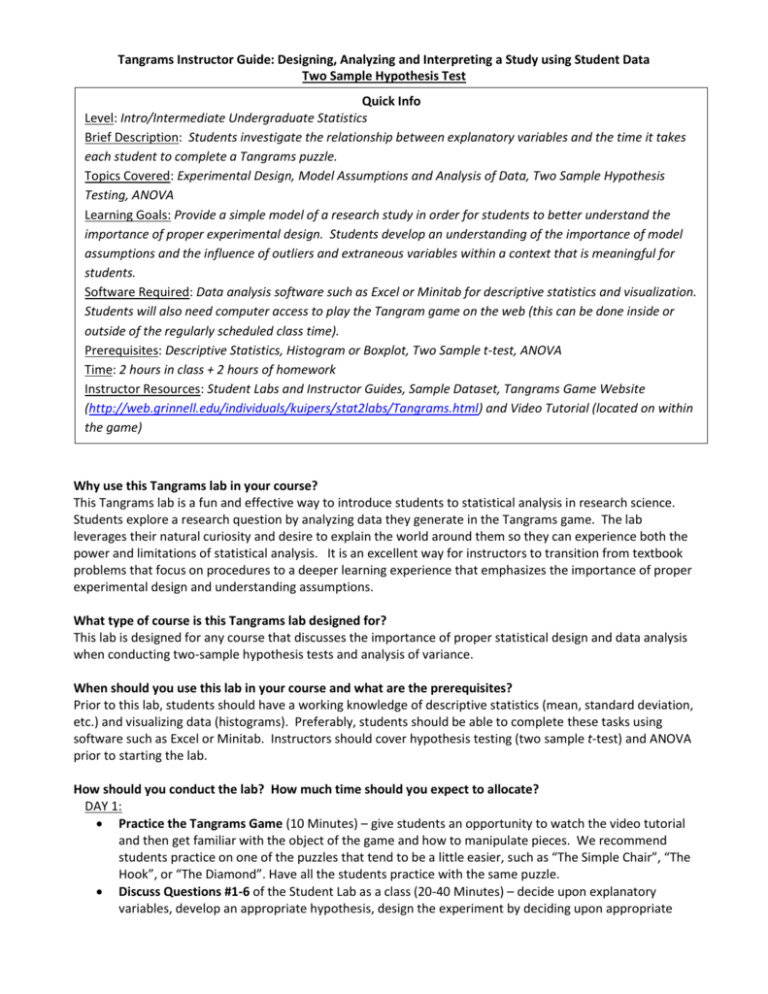
Tangrams Instructor Guide: Designing, Analyzing and Interpreting a Study using Student Data
Two Sample Hypothesis Test
Quick Info
Level: Intro/Intermediate Undergraduate Statistics
Brief Description: Students investigate the relationship between explanatory variables and the time it takes
each student to complete a Tangrams puzzle.
Topics Covered: Experimental Design, Model Assumptions and Analysis of Data, Two Sample Hypothesis
Testing, ANOVA
Learning Goals: Provide a simple model of a research study in order for students to better understand the
importance of proper experimental design. Students develop an understanding of the importance of model
assumptions and the influence of outliers and extraneous variables within a context that is meaningful for
students.
Software Required: Data analysis software such as Excel or Minitab for descriptive statistics and visualization.
Students will also need computer access to play the Tangram game on the web (this can be done inside or
outside of the regularly scheduled class time).
Prerequisites: Descriptive Statistics, Histogram or Boxplot, Two Sample t-test, ANOVA
Time: 2 hours in class + 2 hours of homework
Instructor Resources: Student Labs and Instructor Guides, Sample Dataset, Tangrams Game Website
(http://web.grinnell.edu/individuals/kuipers/stat2labs/Tangrams.html) and Video Tutorial (located on within
the game)
Why use this Tangrams lab in your course?
This Tangrams lab is a fun and effective way to introduce students to statistical analysis in research science.
Students explore a research question by analyzing data they generate in the Tangrams game. The lab
leverages their natural curiosity and desire to explain the world around them so they can experience both the
power and limitations of statistical analysis. It is an excellent way for instructors to transition from textbook
problems that focus on procedures to a deeper learning experience that emphasizes the importance of proper
experimental design and understanding assumptions.
What type of course is this Tangrams lab designed for?
This lab is designed for any course that discusses the importance of proper statistical design and data analysis
when conducting two-sample hypothesis tests and analysis of variance.
When should you use this lab in your course and what are the prerequisites?
Prior to this lab, students should have a working knowledge of descriptive statistics (mean, standard deviation,
etc.) and visualizing data (histograms). Preferably, students should be able to complete these tasks using
software such as Excel or Minitab. Instructors should cover hypothesis testing (two sample t-test) and ANOVA
prior to starting the lab.
How should you conduct the lab? How much time should you expect to allocate?
DAY 1:
Practice the Tangrams Game (10 Minutes) – give students an opportunity to watch the video tutorial
and then get familiar with the object of the game and how to manipulate pieces. We recommend
students practice on one of the puzzles that tend to be a little easier, such as “The Simple Chair”, “The
Hook”, or “The Diamond”. Have all the students practice with the same puzzle.
Discuss Questions #1-6 of the Student Lab as a class (20-40 Minutes) – decide upon explanatory
variables, develop an appropriate hypothesis, design the experiment by deciding upon appropriate
settings in Tangrams, and play the game. We recommend using the “House of Tangrams” puzzle
because most students solve it within a few minutes and there is already a lot of data on the instructor
site for this puzzle. Be prepared to have several students take much longer than the others. Encourage
respect towards others. You may want to assign students to complete the game outside of class, or if
done at the end of class, allow students to leave once they complete the game.
Homework Assignment:
Have students complete Questions #7 and #8 as a homework assignment (possibly in small groups). We
recommend that students do Question #8 as homework because the time it takes students to complete
this question varies greatly.
Day 2:
Discuss Question #8 at the beginning of class. For ease of grading you may want to have a class come
to consensus on the actual data that should be used in the analysis. For example, all students should
agree whether a potential outlier is removed or not.
Have students complete the lab (55 Minutes). If students do not complete the lab during class they
can finish the work as a homework assignment (possibly in small groups).
Day 3: Can be used for Follow-up Activities and Discussion Questions described below
What is the “Multi-game Settings” button on the Tangrams website?
Once the class has decided on settings for the Tangrams game to conduct the experiment under, the
instructor can use the “Pre-Set Settings” button to standardize the settings for the entire class. Here are
instructions:
1. Decide what settings the class will use.
2. Press the “Pre-Set Settings” button.
3. Enter the settings and press Submit.
4. The program will generate a URL. Send this address to your students or post on a website.
When students click open the URL, a Tangrams game will appear with the class settings already filled in as the
defaults. This greatly reduces the number of data collection errors (students who play the game under the
wrong settings).
Here are some helpful hints for instructors using Tangrams for the first time.
1. Spend time talking about the data set before moving onto the statistical procedure. Expose students
to the raw data and involve students in decisions about outliers and data errors. Students should get
an appreciation for the variation involved in conducting experiments. In addition, from our
experience, students like experiencing “real, messy” data when the context is relevant to them.
2. In class assignments where data is only collected for educational purposes typically do not require
Institutional Review Board (IRB) approval. For more advanced courses, instructors may choose to
expose students to the IRB process.
3. Involve the class in deciding upon explanatory variables. However, instructors should have some good
ideas ready in case the class is unable to create good ones. Here are some suggestions: Major
(STEM/non-STEM), Gender, Athlete. Be prepared to discuss controversial results such as if one
genders outperforms the other.
4. Encouraging students to work in pairs or small groups provides a great opportunity for the students
talk about their understanding and teach each other.
5. You can request an example lab using the example data for actual class trials.
6. If you have a small section of students, consider using data already available in the database.
Follow-up Activities and Discussion Questions:
Plan for adequate time after students complete the lab for discussion. Most students will not have problems
performing the statistical tests, but will have difficulty properly interpreting their results and validating
assumptions.
Discussion questions that you can ask your students to emphasize the importance of assumptions when
conducting studies.
a. If you had a chance to play the game under different circumstances, would you be able to perform
better? Describe any factors that may have kept you from doing your best while playing the Tangrams
game.
b. Do you think outside factors (like the ones you or others mentioned in the previous question) could
impact the results of a study? Explain why or why not. For example, should researchers provide some
type of motivation for their subjects in various studies to do their best?
c. If you were conducting this study again, how would you control for any key factors that may influence
each subject’s performance?
Optional Day 3 Activity 1: Ask students to find an article that discusses a recent study. In class, small groups
of students should select one of the articles brought to class and prepare a 5 minute PowerPoint
presentation addressing the following:
a. What was the objective of the study
b. What are the explanatory and response variables
c. Are there graphs used to display the data? If so, do they accurately represent the data?
d. What assumptions were made during the study
e. Which of these assumptions are clearly stated in the article and which are not?
f. Did the article describe how the data was managed? For example, did they delete any outliers,
transform the data, or remove any data points? If so, how did this impact the results?
g. What are the conclusions from the study?
h. What questions would you need to ask before you would have confidence in the study conclusions?
Optional Day 3 Activity 2: At this point this activity can provide a great opportunity for students to be
creative. You can ask small groups to design their own study, addressing other not so obvious conjectures
a. What type of student improves the most when playing this type of game?
b. Is it helpful for a second student to provide hints? (In one study, some students previously found that
male students did worse when assisted by a female student, but females did better when assisted by
males.)
c. What type of student tends to perform best on these types of games?
The Tangram Instructors website discusses additional options.
What else is in this Instructor Guide?
In the next section, we provide detailed comments on the student lab. We suggest questions you can ask to
promote class discussion and point out common issues you may run into when using the lab. Lastly, we
provide sample data from an actual class and suggested answers to each question. For more information and
ideas on using Tangrams in your course, go to
http://web.grinnell.edu/individuals/kuipers/stat2labs/Tangrams.html.
Tangrams: Two Sample Hypothesis Test
Background
Tangrams is an ancient Chinese puzzle where players arrange geometrically shaped pieces into a particular
design by flipping, rotating, and moving them. The online Tangrams game allows students the opportunity to
design many versions of the original game. In this activity you play the role of a statistician as you design a
study, collect data, and then analyze and interpret the results.
Play the Tangrams game one time using the following settings:
Go to the web site: http://statgames.tietronix.com/tangrams/
a. Time: No Restriction
b. Display Timer: Yes
c. Hints Enabled: Yes
d. Type of Puzzle: (given by your instructor)
e. Check the Gather Data on Players box
Player Alias: Use a secret name, any
combination of letters and numbers with no
spaces. Do not use your name or a term that will
identify you.
Group Name: (given by your instructor)
Conduct a hypothesis test about students in our course
Design your own experiment. Note that these games allow you to develop new factors of your own choice.
Which variables do you hypothesize has an impact on game completion time? You could also do a study to
determine if various factors influence whether some people choose to use hints. Address each of the following
points:
1. Identify two different variables that you hypothesize may impact the completion time for the Tangrams
game. Clearly define a question and state the objectives of your experiment.
For example, solving puzzles such as Tangrams requires the use of the spatial orientation functions of the
brain. These same brain functions are used extensively by mathematicians, scientists, and engineers to solve
complex problems. You may be interested in designing a study that will be able to address the following two
questions:
Do students who major in Science, Technology, Engineering, and Mathematics (STEM) perform better
(on average) at Tangrams than students with other majors?
Does the completion time of spatial reasoning games, such as Tangrams, depend on gender?
2. State the null and alternative hypotheses corresponding to the objectives you determined in
Question 1).
3. All students in the class should play the game. Each student is a subject in this study. In this test, we are
conducting an investigation of game completion time. However, we want to make the conditions as similar as
possible for all subjects. Determine the settings for each of the following variables on the Tangram Game:
Time:
Display Timer:
Hints Enabled:
Type of Puzzle:
Group Name:
The first explanatory variable:
o For example, the first variable could be labeled STEM Major with value: Yes if your current or
intended major is in science, technology, engineering or math and No otherwise.
The second explanatory variable:
o For example the second variable could be labeled Gender with value: M for males and F for
females.
4. Identify the response variable, explanatory variable, and units.
5. How many trials (games) will be played? If each subject plays more than one game, how will you determine
the order in which each game will be played?
6. Are there other factors that may be of importance or potentially cause bias in your results? Identify what
other conditions need to be controlled during the experiment to eliminate potential biases.
7. Choose an experimental design and an appropriate technique for analysis. Will you use a paired test, two
independent samples test or other technique? Keep the design and analysis as simple as possible. A
straightforward design and analysis is usually better than complex designs. If the design is too complicated and
the data are not collected properly, even the most advanced statistical techniques may not be able to draw
appropriate conclusions from your experiment.
8. After all students complete the game, use the Recorded Data button to view all data from our study (use
the same Group Name as above). Copy and paste the data into Minitab, Excel, or other statistical software
package. Create a histogram or box plot of your data. Identify any outliers or skewness shown in the plot.
Identify any potential errors in the data (use the Player Alias to identify specific data). Correct or delete the
erroneous data. Briefly explain any changes you made to the data set and describe why you made these
changes.
9. Comment on the shape, center, and spread of particular groups within your data.
10. Use appropriate statistics techniques to calculate a p-value for each hypothesis you are testing.
11. What assumptions need to be checked before we can conclude the analysis in Question 10) is appropriate?
State each assumption and provide a graph or other justification to determine whether the assumptions are
correct.
12. Use the graph in Question 8) and the p-value(s) to summarize your findings. For example, address the
following questions.
If the model assumptions were not perfectly met, explain how your results might be influenced.
Explain whether we can use this data to conclude that your results hold for all students at your school.
Did keeping or removing the outliers influence the results?
If some of the students used hints and others did not, are the results biased?
How might a player's background impact his or her ability to play the game?
All rights are reserved. Users may electronically copy and print in hard copy portions of Stat2labs
solely for personal, and in-class education purposes. Any other use of materials on this Stat2labs
site - including reproduction for purposes other than those noted above, modification,
distribution, or republication - without prior written permission of the author is strictly
prohibited.


